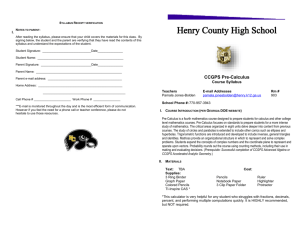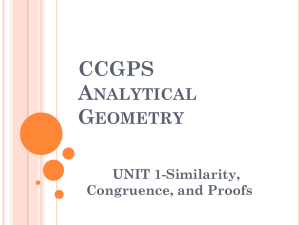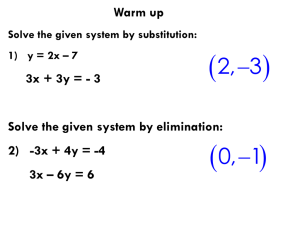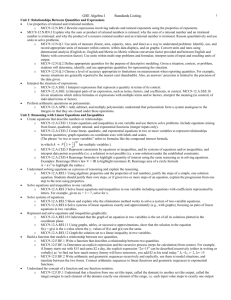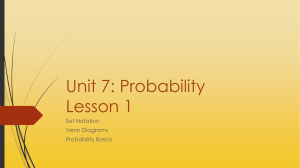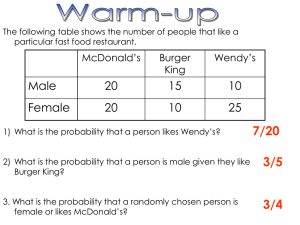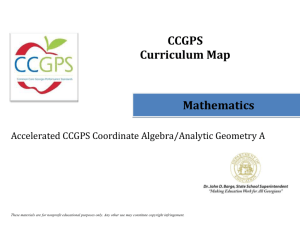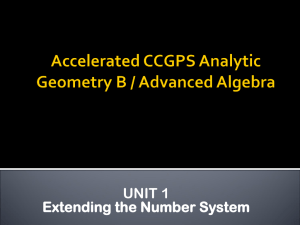Standards
advertisement
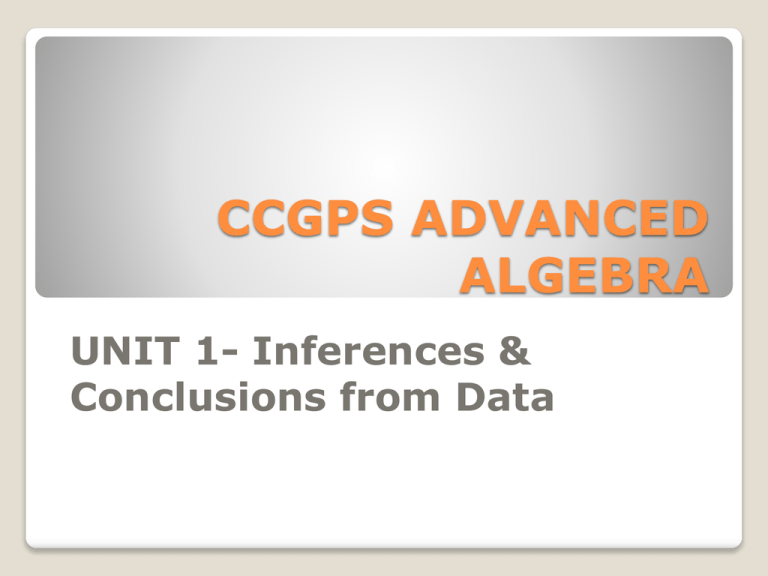
CCGPS ADVANCED ALGEBRA UNIT 1- Inferences & Conclusions from Data MCC9-12.S.ID.2 Use statistics appropriate to the shape of the data distribution to compare center (median, mean) and spread (interquartile range, standard deviation) of two or more different data sets.★ MCC9-12.S.ID.4 Use the mean and standard deviation of a data set to fit it to a normal distribution and to estimate population percentages. Recognize that there are data sets for which such a procedure is not appropriate. Use calculators, spreadsheets, and tables to estimate areas under the normal curve. Summarize, represent, and interpret data on a single count or measurement variable MCC9-12.S.IC.1 Understand statistics as a process for making inferences about population parameters based on a random sample from that population.★ MCC9-12.S.IC.2 Decide if a specified model is consistent with results from a given data-generating process, e.g., using simulation. Understand and evaluate random processes underlying statistical experiments MCC9-12.S.IC.3 Recognize the purposes of and differences among sample surveys, experiments, and observational studies; explain how randomization relates to each.★ MCC9-12.S.IC.4 Use data from a sample survey to estimate a population mean or proportion; develop a margin of error through the use of simulation models for random sampling.★ MCC9-12.S.IC.5 Use data from a randomized experiment to compare two treatments; use simulations to decide if differences between parameters are significant.★ MCC9-12.S.IC.6 Evaluate reports based on data.★ Make inferences and justify conclusions from sample surveys, experiments, and observational studies CCGPS ADVANCED ALGEBRA UNIT 2- Polynomial Functions MCC9-12.N.CN.8 (+) Extend polynomial identities to the complex numbers. MCC9-12.N.CN.9 (+) Know the Fundamental Theorem of Algebra; show that it is true for quadratic polynomials. Use complex numbers in polynomial identities and equations. MCC9-12.A.SSE.1 Interpret expressions that represent a quantity in terms of its context.★ MCC9-12.A.SSE.1a Interpret parts of an expression, such as terms, factors, and coefficients.★ MCC9-12.A.SSE.1b Interpret complicated expressions by viewing one or more of their parts as a single entity.★ MCC9-12.A.SSE.2 Use the structure of an expression to identify ways to rewrite it. Interpret the structure of expressions MCC9-12.A.SSE.4 Derive the formula for the sum of a finite geometric series (when the common ratio is not 1), and use the formula to solve problems★ Write expressions in equivalent forms to solve problems MCC9-12.A.APR.1 Understand that polynomials form a system analogous to the integers, namely, they are closed under the operations of addition, subtraction, and multiplication; add, subtract, and multiply polynomials. Perform arithmetic operations on polynomials MCC9-12.A.APR.2 Know and apply the Remainder Theorem: For a polynomial p(x) and a number a, the remainder on division by x – a is p(a), so p(a) = 0 if and only if (x – a) is a factor of p(x). MCC9-12.A.APR.3 Identify zeros of polynomials when suitable factorizations are available, and use the zeros to construct a rough graph of the function defined by the polynomial. Understand the relationship between zeros and factors of polynomials MCC9-12.A.APR.4 Prove polynomial identities and use them to describe numerical relationships. MCC9-12.A.APR.5 (+) Know and apply that the Binomial Theorem gives the expansion of (x + y)n in powers of x and y for a positive integer n, where x and y are any numbers, with coefficients determined for example by Pascal’s Triangle. (The Binomial Theorem can be proved by mathematical induction or by a combinatorial argument.) Use polynomial identities to solve problems MCC9-12.A.REI.7 Solve a simple system consisting of a linear equation and a quadratic equation in two variables algebraically and graphically. Solve systems of equations MCC9-12.A.REI.11 Explain why the xcoordinates of the points where the graphs of the equations y = f(x) and y = g(x) intersect are the solutions of the equation f(x) = g(x); find the solutions approximately, e.g., using technology to graph the functions, make tables of values, or find successive approximations. Include cases where f(x) and/or g(x) are linear, polynomial, rational, absolute value, exponential, and logarithmic functions.★ Represent and solve equations and inequalities graphically MCC9-12.F.IF.7 Graph functions expressed symbolically and show key features of the graph, by hand in simple cases and using technology for more complicated cases.★ MCC9-12.F.IF.7c Graph polynomial functions, identifying zeros when suitable factorizations are available, and showing end behavior.★ Analyze functions using different representations CCGPS ADVANCED ALGEBRA UNIT 3- Rational & Radical Relationships MCC9-12.A.APR.6 Rewrite simple rational expressions in different forms; write a(x)/b(x) in the form q(x) + r(x)/b(x), where a(x), b(x), q(x), and r(x) are polynomials with the degree of r(x) less than the degree of b(x), using inspection, long division, or, for the more complicated examples, a computer algebra system. MCC9-12.A.APR.7 (+) Understand that rational expressions form a system analogous to the rational numbers, closed under addition, subtraction, multiplication, and division by a nonzero rational expression; add, subtract, multiply, and divide rational expressions. Rewrite rational expressions MCC9-12.A.CED.1 Create equations and inequalities in one variable and use them to solve problems. Include equations arising from linear and quadratic functions, and simple rational and exponential functions.★ MCC9-12.A.CED.2 Create equations in two or more variables to represent relationships between quantities; graph equations on coordinate axes with labels and scales.★ (Limit to radical and rational functions.) Create equations that describe numbers or relationships MCC9-12.A.REI.2 Solve simple rational and radical equations in one variable, and give examples showing how extraneous solutions may arise. Understand solving equations as a process of reasoning and explain the reasoning MCC9-12.A.REI.11 Explain why the xcoordinates of the points where the graphs of the equations y = f(x) and y = g(x) intersect are the solutions of the equation f(x) = g(x); find the solutions approximately, e.g., using technology to graph the functions, make tables of values, or find successive approximations. Include cases where f(x) and/or g(x) are rational. Represent and solve equations and inequalities graphically MCC9-12.F.IF.4 For a function that models a relationship between two quantities, interpret key features of graphs and tables in terms of the quantities, and sketch graphs showing key features given a verbal description of the relationship. Key features include: intercepts; intervals where the function is increasing, decreasing, positive, or negative; relative maximums and minimums; symmetries; end behavior; and periodicity.★ (Limit to radical and rational functions.) MCC9-12.F.IF.5 Relate the domain of a function to its graph and, where applicable, to the quantitative relationship it describes. (Limit to radical and rational functions.) Interpret functions that arise in applications in terms of the context MCC9-12.F.IF.7 Graph functions expressed symbolically and show key features of the graph, by hand in simple cases and using technology for more complicated cases.★ (Limit to radical and rational functions.) MCC9-12.F.IF.7b Graph square root, cube root.★ MCC9-12.F.IF.7d (+) Graph rational functions, identifying zeros and asymptotes when suitable factorizations are available, and showing end behavior.★ MCC9-12.F.IF.9 Compare properties of two functions each represented in a different way (algebraically, graphically, numerically in tables, or by verbal descriptions). (Limit to radical and rational functions.) Analyze functions using different representations CCGPS ADVANCED ALGEBRA UNIT 4- Exponential & Logarithms MCC9-12.A.SSE.3 Choose and produce an equivalent form of an expression to reveal and explain properties of the quantity represented by the expression.★ (Limit to exponential and logarithmic functions.) MCC9-12.A.SSE.3c Use the properties of exponents to transform expressions for exponential functions. Write expressions in equivalent forms to solve problems MCC9-12.F.IF.7 Graph functions expressed symbolically and show key features of the graph, by hand in simple cases and using technology for more complicated cases.★ (Limit to exponential and logarithmic functions.) MCC9-12.F.IF.7e Graph exponential and logarithmic functions, showing intercepts and end behavior, and trigonometric functions, showing period, midline, and amplitude.★ MCC9-12.F.IF.8 Write a function defined by an expression in different but equivalent forms to reveal and explain different properties of the function. (Limit to exponential and logarithmic functions.) MCC9-12.F.IF.8b Use the properties of exponents to interpret expressions for exponential functions. (Limit to exponential and logarithmic functions.) Analyze functions using different representations MCC9-12.F.BF.5 (+) Understand the inverse relationship between exponents and logarithms and use this relationship to solve problems involving logarithms and exponents. Build new functions from existing functions MCC9-12.F.LE.4 For exponential models, express as a logarithm the solution to ab(ct) = d where a, c, and d are numbers and the base b is 2, 10, or e; evaluate the logarithm using technology.★ Construct and compare linear, quadratic, and exponential models and solve problems CCGPS ADVANCED ALGEBRA UNIT 5- Trigonometric Functions MCC9-12.F.IF.7 Graph functions expressed symbolically and show key features of the graph, by hand in simple cases and using technology for more complicated cases.★ (Limit to trigonometric functions.) MCC9-12.F.IF.7e Graph exponential and logarithmic functions, showing intercepts and end behavior, and trigonometric functions, showing period, midline, and amplitude.★ Analyze functions using different representations MCC9-12.F.TF.1 Understand radian measure of an angle as the length of the arc on the unit circle subtended by the angle. MCC9-12.F.TF.2 Explain how the unit circle in the coordinate plane enables the extension of trigonometric functions to all real numbers, interpreted as radian measures of angles traversed counterclockwise around the unit circle. Extend the domain of trigonometric functions using the unit circle MCC9-12.F.TF.5 Choose trigonometric functions to model periodic phenomena with specified amplitude, frequency, and midline.★ Model periodic phenomena with trigonometric functions MCC9-12.F.TF.8 Prove the Pythagorean identity (sin A)2 + (cos A)2 = 1 and use it to find sin A, cos A, or tan A, given sin A, cos A, or tan A, and the quadrant of the angle. Prove and apply trigonometric identities CCGPS ADVANCED ALGEBRA UNIT 6- Mathematical Modeling MCC9-12.A.CED.1 Create equations and inequalities in one variable and use them to solve problems. Include equations arising from linear and quadratic functions, and simple rational and exponential functions.★ MCC9-12.A.CED.2 Create equations in two or more variables to represent relationships between quantities; graph equations on coordinate axes with labels and scales.★ MCC9-12.A.CED.3 Represent constraints by equations or inequalities, and by systems of equations and/or inequalities, and interpret solutions as viable or non-viable options in a modeling context.★ MCC9-12.A.CED.4 Rearrange formulas to highlight a quantity of interest, using the same reasoning as in solving equations. Create equations that describe numbers or relationships MCC9-12.F.IF.4 For a function that models a relationship between two quantities, interpret key features of graphs and tables in terms of the quantities, and sketch graphs showing key features given a verbal description of the relationship. Key features include: intercepts; intervals where the function is increasing, decreasing, positive, or negative; relative maximums and minimums; symmetries; end behavior; and periodicity.★ MCC9-12.F.IF.5 Relate the domain of a function to its graph and, where applicable, to the quantitative relationship it describes.★ MCC9-12.F.IF.6 Calculate and interpret the average rate of change of a function (presented symbolically or as a table) over a specified interval. Estimate the rate of change from a graph.★ Interpret functions that arise in applications in terms of the context MCC9-12.F.IF.7 Graph functions expressed symbolically and show key features of the graph, by hand in simple cases and using technology for more complicated cases.★ MCC9-12.F.IF.7a Graph linear and quadratic functions and show intercepts, maxima, and minima.★ MCC9-12.F.IF.7b Graph square root, cube root, and piecewise-defined functions, including step functions and absolute value functions.★ MCC9-12.F.IF.7c Graph polynomial functions, identifying zeros when suitable factorizations are available, and showing end behavior.★ MCC9-12.F.IF.7d (+) Graph rational functions, identifying zeros and asymptotes when suitable factorizations are available, and showing end behavior.★ Analyze functions using different representations MCC9-12.F.IF.7e Graph exponential and logarithmic functions, showing intercepts and end behavior, and trigonometric functions, showing period, midline, and amplitude.★ MCC9-12.F.IF.8 Write a function defined by an expression in different but equivalent forms to reveal and explain different properties of the function. MCC9-12.F.IF.8a Use the process of factoring and completing the square in a quadratic function to show zeros, extreme values, and symmetry of the graph, and interpret these in terms of a context. MCC9-12.F.IF.8b Use the properties of exponents to interpret expressions for exponential functions. MCC9-12.F.IF.9 Compare properties of two functions each represented in a different way (algebraically, graphically, numerically in tables, or by verbal descriptions). Analyze functions using different representations MCC9-12.F.BF.1 Write a function that describes a relationship between two quantities.★ MCC9-12.F.BF.1a Determine an explicit expression, a recursive process, or steps for calculation from a context. MCC9-12.F.BF.1b Combine standard function types using arithmetic operations. MCC9-12.F.BF.1c (+) Compose functions. Build a function that models a relationship between two quantities MCC9-12.F.BF.3 Identify the effect on the graph of replacing f(x) by f(x) + k, k f(x), f(kx), and f(x + k) for specific values of k (both positive and negative); find the value of k given the graphs. Experiment with cases and illustrate an explanation of the effects on the graph using technology. Include recognizing even and odd functions from their graphs and algebraic expressions for them. MCC9-12.F.BF.4 Find inverse functions. MCC9-12.F.BF.4a Solve an equation of the form f(x) = c for a simple function f that has an inverse and write an expression for the inverse. MCC9-12.F.BF.4b (+) Verify by composition that one function is the inverse of another. MCC9-12.F.BF.4c (+) Read values of an inverse function from a graph or a table, given that the function has an inverse. Build new functions from existing functions MCC9-12.G.GMD.4 Identify the shapes of two-dimensional crosssections of three-dimensional objects, and identify threedimensional objects generated by rotations of two-dimensional objects. Visualize relationships between two-dimensional and threedimensional objects MCC9-12.G.MG.1 Use geometric shapes, their measures, and their properties to describe objects (e.g., modeling a tree trunk or a human torso as a cylinder).★ MCC9-12.G.MG.2 Apply concepts of density based on area and volume in modeling situations (e.g., persons per square mile, BTUs per cubic foot).★ MCC9-12.G.MG.3 Apply geometric methods to solve design problems (e.g., designing an object or structure to satisfy physical constraints or minimize cost; working with typographic grid systems based on ratios).★ Apply geometric concepts in modeling situations
